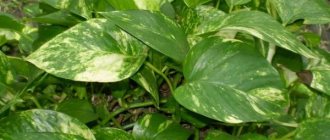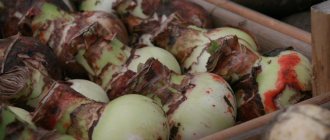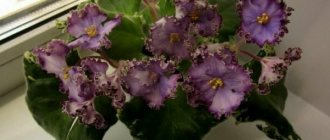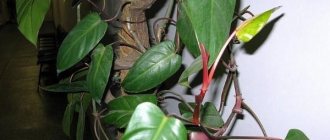Abutilon is a perennial evergreen plant from the Malvaceae family .
In its natural environment it is found in the tropics of South America, Asia, and Africa. China is considered the homeland. It grows very quickly, sometimes reaching 2 m. Some species in nature grow up to 4 m. With proper care, abutilon pleases with long-lasting flowering - from April to late autumn. Flowers can be of different colors: red, peach, salmon, purple, pink. They look like magic lanterns and are formed on long stalks at the end of the shoot, while the growth of the shoot does not stop. The plant is often called the indoor maple because its wedge-shaped green leaves with jagged edges resemble the foliage of a tree.
| In one season, the plant doubles or triples in growth. |
| Blooms in autumn, summer and spring. |
| Abutilone is easy to grow. |
| Perennial. |
Description and characteristics of the plant
The rope maple belongs to the genus Abutilon in the family Malvaceae. This genus of plants includes approximately 150 species of various perennial and annual shrubs, herbs and also trees. However, out of this large number of species, only a few of them are grown as ornamental plants.
Did you know? Coarse abutilone fibers are used for the production of ropes and various woven products. Thanks to this feature, this plant received its second name “rope plant”.
Abutilon is a small tree or shrub that remains green all year round. The plant is native to South America, and in particular Brazil. Under natural conditions, the ropeworm is found in Africa and the subtropical and tropical zones of Australia, China and India.
This plant has dense stems that weave strongly at the base. The bark of woody shoots has a brownish-purple tint. Along the entire trunk there are graceful leaves, the size of which varies from 10 to 20 cm, and the shape resembles a maple or grape leaf.
In appearance, the flowers resemble a bell, but depending on the variety, they can be found in the shape of a cup, and are directed downward. The length of the flower can be 4–8 cm.
They are smooth and terry, and the color of the petals is white, cream, orange, pink, red, violet and purple. The buds bloom for several days, but new bells or calyxes appear in place of the fading ones.
Flowering is lush and long-lasting, beginning in April - May and lasting until October - November. Considering its decorative appearance, the question arises: can it be kept at home?
This plant can be found both in front gardens and in gardens or parks, however, from all the diversity, some varieties of rope plant have been bred and grown as indoor plants. With proper care, indoor species can reach 2 m in height.
Thanks to the work of breeders, varieties have been developed that have compact sizes, strong branching of the trunk, and a wide variety of shades of flowers and leaves.
Ornamental flowering plants also include Tabernemontana, Jacobinia, Pentas, Crossandra, and Oleander.
Only the following species are grown as home flowers:
- abutilon Bella;
- Darwin's cable car;
- Megapotamian cable car;
- Bellevue cable car;
- striped or spotted ropetail;
- hybrid cable car;
- suntense cable car;
- abutilon pink panther;
- panther roper;
- abutilone grapeleaf;
- abutilone isabella;
- abutilon AS-Kishmish;
- ropeman of Theophrastus;
- organza rope;
- roper Isabella;
- chicken abutilon;
- apricot rope;
- abutilone Zlata;
- dwarf ropetail;
- abutilone variegated;
- abutilone wedge-shaped;
- Amazonian ropeweed;
- variegated ropeweed;
- abutilone yellow.
In addition, flower lovers who are worried about their loved ones and decided to acquire this variegated plant are interested in whether this flower is poisonous or not, because many tropical plants have toxic properties.
Abutilone is not a poisonous plant, but even has a number of beneficial properties and is widely used in folk medicine in its homeland. A decoction of abutilon leaves is used to wash ulcers and wounds; it is also used as a rinse for stomatitis and during teething.
It can be used to relieve symptoms of fever or cold. A compress based on leaves and flowers is used for wounds and burns that are previously crushed.
In addition to traditional medicine, it is also used in official medicine. Research on this plant has proven that it contains antioxidants, hepatoprotectors and immunomodulators, thus it is a natural antibacterial, antimalarial, antimicrobial or anti-inflammatory agent.
Megapotamian abutilon (A. megapotamicum)
A plant with unusually shaped flowers has popularly earned the name “Chinese lantern”. Indeed, the enlarged carmine or red base of the corolla is very reminiscent of the traditional lamp made of bright rice paper. The petals can be either yellow, orange or purple. Abutilon megapotamensis blooms for a long time; at home, it can occur almost all year round.
Abutilon of this decorative species forms graceful subshrubs or is grown as a hanging crop that requires a solid base or support.
For home and garden floriculture, the variegated form of abutilon megapotamensis with elongated dark-colored shoots is interesting. At the top of the stems there are hanging yellow-red lanterns. But the peculiarity of the form is not in them, but in the spotted yellow-green foliage of a pointed, almost lanceolate shape.
Abutilon megapotamian variety Orange Hot Lava has bright orange flowers with a voluminous airy bract of a purple hue. Leaf petioles, peduncles and shoots are dark, almost purple. The foliage is jagged, green, with a pointed tip and darker veins. The flowers externally resemble a bell, consisting of two tiers. The upper petals are distinguished by the presence of dark veins, and the lower ones are darker in color.
Optimal conditions for growing a flower
Ropeweed is quite easy to care for and does not require special growing conditions. It is necessary to choose the right workplace, choose the right pot and soil, regularly water, fertilize and prune.
The domestic maple, as a representative of tropical and subtropical plants, is light-loving, so it is necessary to provide a sufficient level of light not only in summer, but also in winter. If there is not enough lighting, the plant stops blooming and the shoots begin to stretch.
To avoid these problems, it is best to choose a south-facing window for the winter, but in the summer it is necessary to avoid direct sunlight, as they can harm young shoots. In summer, the rope plant can be moved to a loggia, open terrace or garden, but the plant should be protected from the wind.
In the warm season, the optimal temperature is +22…+25ºС, and in winter - +12…+15ºС. If the temperature drops below +12ºС, the plant sheds its leaf cover. The same consequences can occur as a result of exposure to drafts.
Additional moisturizing is not required. In winter, when the flower is in close proximity to the radiator, there is no proper watering and ventilation of the room, the air becomes dry, the leaves begin to dry and curl, so you should periodically humidify the air.
This can be done using a mist or a humidifier. It will also be useful to periodically bathe the plant in a warm shower (once or twice a month).
If in winter the temperature in the house rises above +15ºС, then abutilon is watered as necessary (when the soil dries out). However, you need to monitor the soil so that it does not become waterlogged or dry out, because the leaves may fall off. In summer, the frequency of soil moisture increases to 3 times every 7 days.
Important! Indoor maple needs abundant watering during the period of active growth; in winter, when the temperature remains within +12...+15ºС, watering is reduced.
Domestic maple needs regular fertilization, so during the growing season it should be fertilized once every 10–14 days. Fertilizing is applied both with watering and by spraying, alternately using mineral and organic complexes.
If with the onset of winter abutilon does not stop blooming, then fertilizer is continued to be applied. If there are no buds during this period of the year, fertilizer is no longer applied, thereby allowing the plant to rest and gain strength for the next flowering season.
The plant should be pruned periodically. Thus, an attractive shape is formed and the ropeworm reproduces. It is pruned in February - March.
Preparing for landing
Before considering the rules of transplantation, it is necessary to choose the right container for the ropeway and determine what kind of land is needed. When choosing a pot or other container for planting a flower, you must remember that the flower is replanted annually.
And since the flower grows quite quickly and the roots also develop rapidly, the container where the flower will grow must be deep enough. For young cuttings, choose a pot or flowerpot whose diameter varies between 7–10 cm.
Find out how to properly plant indoor flowers in a pot.
The rope plant prefers non-acidic, airy soil.
You can prepare the desired mixture at home using:
- 1 part humus;
- 2 parts of turf land;
- 1 part leaf soil;
- 0.5 parts sand.
You can also use ready-made soil, for example, “Palma”, which is sold in any flower shop.
Reproduction and planting technologies
Abutilone propagates in two ways: seeds and cuttings. After pruning the plant, a large number of cuttings appear that can be rooted. However, indoor maple can also be grown from seeds.
Cuttings
When wondering how to propagate rope plant while maintaining all the characteristics of an adult plant, cuttings are optimal, which can be used for any variety of abutilon.
In this propagation method, cuttings are used only from the top of the flower. Their length should be no more than 15 cm and have 3-4 leaves and buds. If there is a bud on it, then it must be cut off so that the plant can take root faster.
Important! Abutilon cuttings are planted in the spring so that by summer the plant becomes stronger and can delight you with lush greenery and flowering.
After cutting, the shoot does not need special treatment and can be immediately placed in a separate tall glass with moist soil. In order for it to take root well, greenhouse conditions are artificially created for it.
In this case, it is necessary to constantly maintain moist soil and air, provide a sufficient amount of light and an air temperature of +25ºС. If all conditions are met, then after 2 weeks the cuttings will take root and can be transplanted into a small pot.
If necessary, the flower is transplanted into a larger pot. These plants are cared for in the same way as adults.
Seeds
This method does not require special skills and is quite simple. The seeds need to be prepared first. To do this, they are sorted out and only the largest ones are left, after which they are soaked in water.
If some of them float to the surface, then these seeds must be selected, since they cannot be used for planting, because the germination rate will be very low.
Important! Hybrid varieties of abutilone cannot be grown from seeds, since the main characteristics of the mother plant will be lost.
A container with a mixture of peat soil and sand is ideal for sowing seeds. It is necessary to sow seeds to a depth of no more than 8 mm and no less than 5. After sowing, the soil is well moistened and covered with a lid or special film, thus creating a greenhouse effect.
The temperature must be maintained within +22…+28ºС. The container with the seeds is placed in a well-lit place. To prevent the air from stagnating in the minigreenhouse, it must be periodically ventilated and the soil must be moistened, if necessary, by spraying.
20–35 days after planting, the first shoots hatch. Plants can be replanted only when the sprouts have 3-4 leaves. The pots are changed gradually; in the first year you can replant the flower up to 4 times.
Plants grown in this way begin to bloom within 3-4 months from the moment of planting.
Grape leaf abutilon (A. vitifolium)
The hybrid variety Suntense, obtained from abutilon grapevine, has become a sought-after ornamental crop. Plants of this species are quite cold-resistant and are subshrubs up to 180 cm high. Flowering consists of the formation of a mass of large cup-shaped flowers of lilac, bluish, pink or white color. The plant is deciduous. The leaves are hard, pubescent, green or with a noticeable silvery tint.
In potted culture, it prefers sunny, quiet places, nutritious soil and moderate watering. To limit growth, at home abutilon is planted in small pots.
The photo of abutilon variety White Charm gives a full idea of the foliage of this species, which truly resembles the leaves of cultivated grapes. The variety is interesting for its white corollas, which is rare for abutilon, and their size. The diameter of the wide-open flower reaches 7–9 cm.
Features of care and cultivation
The rope plant grows quickly in favorable conditions, which is why it is necessary to provide optimal conditions and care.
Fertilizer and watering regime
During the period of active growth, Abutilon needs regular feeding, which is done up to 3 times every 30 days. In the off-season, the rope plant must be given the opportunity to rest, so they stop applying fertilizer. However, if the plant blooms all year round, then fertilizer continues to be applied in the same mode.
Moisten the soil as needed:
- in summer - a couple of times every 7 days;
- in winter - a couple of times every 14 days, at temperatures above +15°C.
Flowering period
For novice flower growers, it is always interesting when the home maple tree blooms. It blooms in April or May and pleases with its flowering right up to November or October, however, if proper care is provided, the rope plant can bloom all year round.
Trimming and shaping
Since abutilon grows quite quickly, it needs regular pruning. It can be produced at any time of the year. However, it is better to form a crown in early spring, and during the growing season it is better to trim only weak shoots.
To form a tree and lignify one stem, it is necessary to periodically remove all side shoots. And in order to form abutilon bushes, you need to pinch the top of the plant. It is important to understand when to pinch the plant. To increase the branching of the rope plant, young shoots are pinched at the end of winter and beginning of spring.
Timing and technology of transplantation
You can replant a young flower several times during the first year, and starting from the second year, replanting is done every year and only in the spring. Large plants are replanted no more than once every few years. The container should be one finger larger than the previous one. In such a container the plant will grow rapidly and bloom profusely.
Transplantation is carried out by transferring a clod of earth, thus minimizing the likelihood of damage to the root system. Expanded clay, pebbles or clay shards are used as a drainage layer.
Diseases and pests
Unfortunately, abutilone can be affected by the following pests:
- scale insect;
- aphid;
- whitefly;
- spider mite;
- mealy worm.
As a result of such exposure, various leaf diseases develop. To combat these pests, special preparations are used or the leaf plate can be treated with a mild soap solution. When identifying spider mites, it is enough to increase the air humidity. This can be done by using a humidifier or spraying the flower.
Did you know? Abutilone cryptopetalum is included in the Red Book of the United States. To restore its population, seeds of ripened fruits are collected, which are first grown in special nurseries, and then the plant is transplanted into the natural environment.
If the soil is waterlogged, the plant may develop root rot. In order to combat this problem, it is necessary to adjust the watering regime and prevent soil acidification. Chlorosis may also occur, which is a consequence of the negative influence of spider mites.
Why doesn't it bloom
Abutilon may not bloom if the soil is waterlogged or overdried, which most often happens in winter or summer under the influence of direct sunlight. Buds may form poorly or not form at all if the soil is depleted or the pot is small.
In addition, the plant needs regular pruning to ensure lush flowering.
Why does it drop leaves?
If there is a strong temperature difference, a lack or excess of moisture in the soil, or exposure to drafts, the leaves of an indoor maple tree may fall off.
Why do the leaves turn yellow?
As a result of exposure to high temperatures, direct sunlight and a deficiency of nutrients, the foliage of the flower begins to turn yellow and become stained. Lack of light causes the leaves to turn pale or dull.
Abutilon has conquered the hearts of many flower growers around the world with its lush and bright flowering. In addition, its unpretentiousness in cultivation allows you to easily grow a large tree or a lush bush from a seed or a small cutting; the main thing is to ensure proper care for this exotic flower.
Abutilone hybrid (A. hybridum)
Most of the abutilons grown in gardens and on windowsills cannot be found in nature. These are numerous hybrids, often of unknown origin, which are today grouped under the name Abutilon hybridum. Due to the uncertainty of origin, such a formation is considered not a species, but an extensive varietal group.
Hybrid abutilons are compact, highly branched plants up to one and a half meters high. The leaves of this beautiful crop are heart-shaped or ovate, less often three- or five-fingered, serrated along the edge. The leaf blades on both sides are covered with short, hard hair, and their color can vary from light green or even yellowish to variegated.
Hybrid abutilon attracts attention with bell-shaped flowers located in the axils, singly or in pairs. Corollas with a diameter of up to 5 cm are held on thin drooping peduncles. The petals amaze with a variety of shades from deep burgundy to white.
Among abutilons of hybrid origin there are both shrubs and subshrubs, which at home require mandatory pruning and shaping.
Flower growers have a lot of interesting varieties and hybrids at their disposal, among the most popular is the Bella Select Mix series of hybrid abutilons, which includes plants with flowers of pale pink, pink, coral, white and pale yellow.
The photo shows abutilon Bella in a bright coral color with a lighter center of the corolla and deep pink edges of the petals. The foliage of such a plant is smooth, green, three- or five-lobed.
No less interesting is Abutilon Bella Yellow with dark shoots and yellow flowers that definitely will not go unnoticed.
Domestic breeders offer lovers of indoor plants abutilon Juliet with a height of up to 55–60 cm and large simple flowers of different shades. The plant is unpretentious and easily tolerates all the peculiarities of home maintenance. Another variety, Abutilon Organza, with flowers in white, golden, pink and rich carmine shades, has similar properties.
You can create a unique composition of plants with different flower colors if you purchase abutilone seeds in a mixture. In this case, plants of the same variety require a uniform approach to maintenance and care, and a lush multi-colored cap of bell flowers will appear above the pot.
One of the most famous hybrid abutilons is the White King variety, which forms compact bushes no more than 40 cm in height. The foliage on such plants is velvety, dark green or gray, the flowers are bell-shaped, completely white, with a yellow pistil and the same bright stamens.
Lovers of double flowers should pay attention to the hybrid abutilon variety Pink Swirls with soft pink corollas and light lobed foliage.
It is interesting that among the abutilons, there are also decorative leafy varieties. The flowering of the abutilon variety Souvenir de Bonn shown in the photo can be called mediocre compared to previous plants, but its leaves will clearly attract attention. The subshrub is about half a meter high and is densely covered with five-fingered pointed leaves. The leaf blade is dark green, with streaked veins and a bright white edging along the edge.











